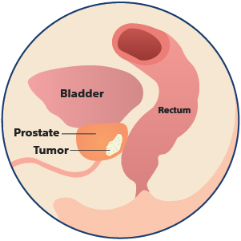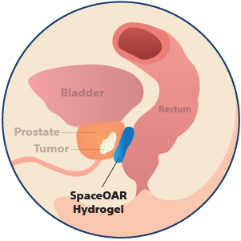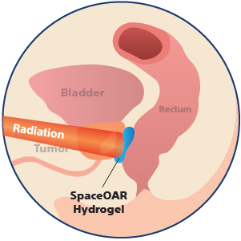SpaceOAR
SpaceOAR Hydrogel
What is SpaceOAR?

SpaceOAR Hydrogel is an option for men who undergo radiation treatment for prostate cancer. It acts as a spacer providing space between the rectum and the prostate, reducing radiation exposure to the rectum. It is injected into place prior to the start of radiation treatment. Patients may be awake or asleep under general anesthesia for the procedure. SpaceOAR Hydrogel remains stable during radiation therapy and then is gradually absorbed by the body after radiation therapy has been completed.
SpaceOAR Benefits

SpaceOAR Hydrogel is made up of two liquids that when combined, form a soft gel that is mostly made of water. This hydrogel temporarily moves the rectum a half inch away from the prostate. By separating the prostate from the rectum, it reduces these common side effects:
- Rectal pain and bleeding
- Chronic diarrhea
- Urinary urgency and leakage
- Erectile dysfunction
SpaceOAR Educational Video
How SpaceOAR Works
Anatomy without SpaceOAR

Anatomy with SpaceOAR

SpaceOAR with Radiation

SpaceOAR FAQs
What is SpaceOAR Hydrogel?
SpaceOAR Hydrogel is an absorbable gel material that creates a temporary space between the prostate and the rectum, potentially reducing radiation dose to the rectum during prostate cancer radiation. It separates the prostate and rectum and is naturally absorbed by the body in about six months. More than 50,000 patients worldwide have been successfully treated with SpaceOAR Hydrogel.
For what condition is SpaceOAR Hydrogel used?
SpaceOAR Hydrogel is an option for men preparing to undergo radiation treatment for prostate cancer. It is designed to reduce the radiation dose delivered to the rectum and help maintain rectal function.
How common is prostate cancer?
Prostate cancer is the most common cancer in American men. In the United States, more than 183,000 new cases of prostate cancer are diagnosed each year. More than 60,000 American men opt for radiation treatment every year to treat their prostate cancer.
How is prostate cancer treated?
Prostate cancer is highly treatable and there are a number of treatment options available based on things like the stage of the disease, a person’s age, how healthy they are and their personal preferences. Three common options include watchful waiting to see if the tumor grows or spreads, surgery to remove all or part of the prostate, or radiation to kill cancer cells and shrink the tumors.
What are the common side effects of prostate cancer treatment?
The side effects of prostate cancer treatment vary based on the treatment method chosen. Surgery and radiation have been shown to be the two most successful treatments for low and intermediate grade prostate cancer. The most common complications following surgery are related to the urinary system, such as incontinence and erectile dysfunction, while complications following radiation are often related to rectal radiation injury (bleeding, diarrhea).
Why is SpaceOAR Hydrogel important for patients?
When treating prostate cancer patients with radiation therapy, the goal is to kill the cancer cells while avoiding damage to surrounding healthy tissue. The prostate is next to the rectum and naturally separated by a small space. Due to the proximity, prostate radiation therapy can unintentionally cause damage to the rectum, which can lead to issues with bowel function. SpaceOAR Hydrogel is a gel spacer that temporarily moves the rectal wall farther away from the prostate. By separating the prostate from the rectum, the radiation dose delivered to the rectum is reduced, which may lessen damage to the rectum. Clinical data demonstrated the benefits of SpaceOAR Hydrogel, including a reduction of rectal injury resulting in maintained bowel function and a higher likelihood to maintain urinary and sexual function.
What are the risks of SpaceOAR Hydrogel?
As with any medical treatment, there are some risks involved with the use of SpaceOAR Hydrogel. Potential complications include, but are not limited to: pain associated with SpaceOAR Hydrogel injection; pain or discomfort associated with SpaceOAR Hydrogel; needle penetration of the bladder, prostate, rectal wall, rectum or urethra; injection of SpaceOAR Hydrogel into the bladder, prostate, rectal wall, rectum or urethra; local inflammatory reactions; infection; injection of air, fluid or SpaceOAR Hydrogel intravascularly; urinary retention; rectal mucosal damage, ulcers, necrosis; bleeding; constipation; and rectal urgency.
What is the gel made of? Is it safe?
SpaceOAR Hydrogel is made up of two liquids that, when combined, form a soft gel material mostly made of water. Studies have shown that the material is biocompatible, can be used in the body without causing injury or a reaction and can be safely absorbed by the body. The material that the SpaceOAR Hydrogel is made from has been used in other implants such as surgical sealants used in the eye, brain and spine.
Where is the procedure done and how long does it take?
SpaceOAR Hydrogel can be implanted during a minimally invasive outpatient procedure in a hospital, surgery center, outpatient clinic or doctor’s office prior to the start of radiation treatment. It is typically not a lengthy procedure – usually about 30 minutes.
How is SpaceOAR Hydrogel implanted? Is a patient awake during the procedure?
The SpaceOAR Hydrogel is injected as liquid through a needle placed between the rectum and the prostate. It can be implanted under general anesthesia that will put a patient to sleep during the procedure or a local anesthetic that will numb the injection area.
Do patients feel any discomfort or pain during or after the procedure?
Patients may feel a pinprick or pressure but should not feel any major discomfort. After the procedure, they may experience some temporary discomfort at the injection site, but most SpaceOAR Hydrogel patients report no prolonged discomfort and are usually able to resume their normal activities shortly after the gel is implanted.
In what type of radiation treatment can SpaceOAR Hydrogel be used?
SpaceOAR Hydrogel can be used in all types of radiation therapy for the prostate.
How soon after the procedure can patients return to their normal activities?
Patients are usually able to go back to normal activities shortly after SpaceOAR Hydrogel is implanted.
How long does the hydrogel remain in the body?
SpaceOAR Hydrogel stays in place for about three months. After about six months, the hydrogel is naturally absorbed into the body and removed through urine.
Has SpaceOAR Hydrogel been clinically tested?
SpaceOAR Hydrogel has been evaluated in clinical studies and has been shown to be safe and effective in reducing the side effects of radiation therapy to the rectal area. In a randomized clinical study, men who underwent radiation therapy without SpaceOAR Hydrogel were eight times more likely to experience a decline in bowel, urinary and sexual function when compared to men who underwent radiation therapy with SpaceOAR Hydrogel, at a median follow-up of three years.
Is SpaceOAR Hydrogel covered by insurance?
SpaceOAR Hydrogel is covered by many insurance plans and is reimbursed by Medicare on a case-by-case basis. Patients should verify their benefits with their insurance company in advance of the scheduled procedure.
How many patients have been treated with SpaceOAR Hydrogel?
To date, more than 100,000 patients around the world have been successfully treated with SpaceOAR Hydrogel.
Locations

NW Portland (Suite 210)
-
2230 NW Pettygrove Street, Suite 210
Portland, OR 97210 - (503) 223-6223
- (503) 223-3665

SW Portland / St. Vincent Hospital
-
9135 SW Barnes Rd #663
Portland, OR 97225 - (503) 297-1078
- (503) 292-2176
